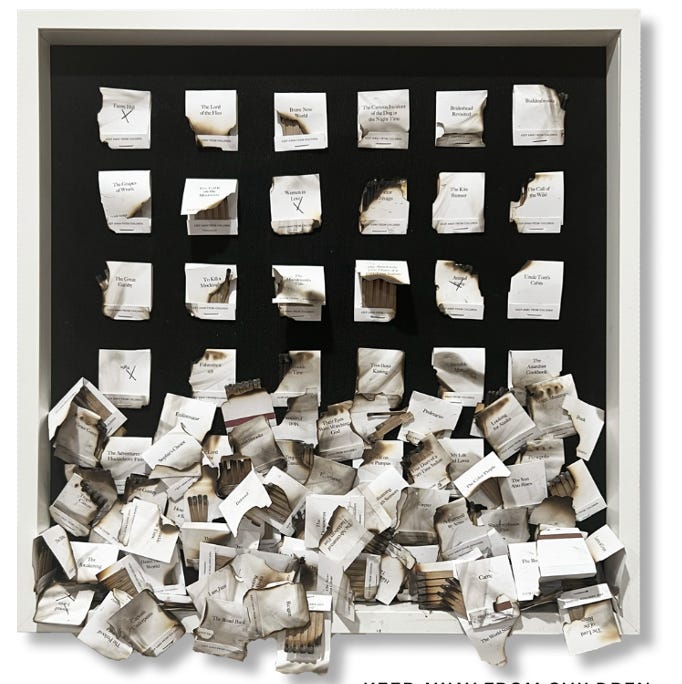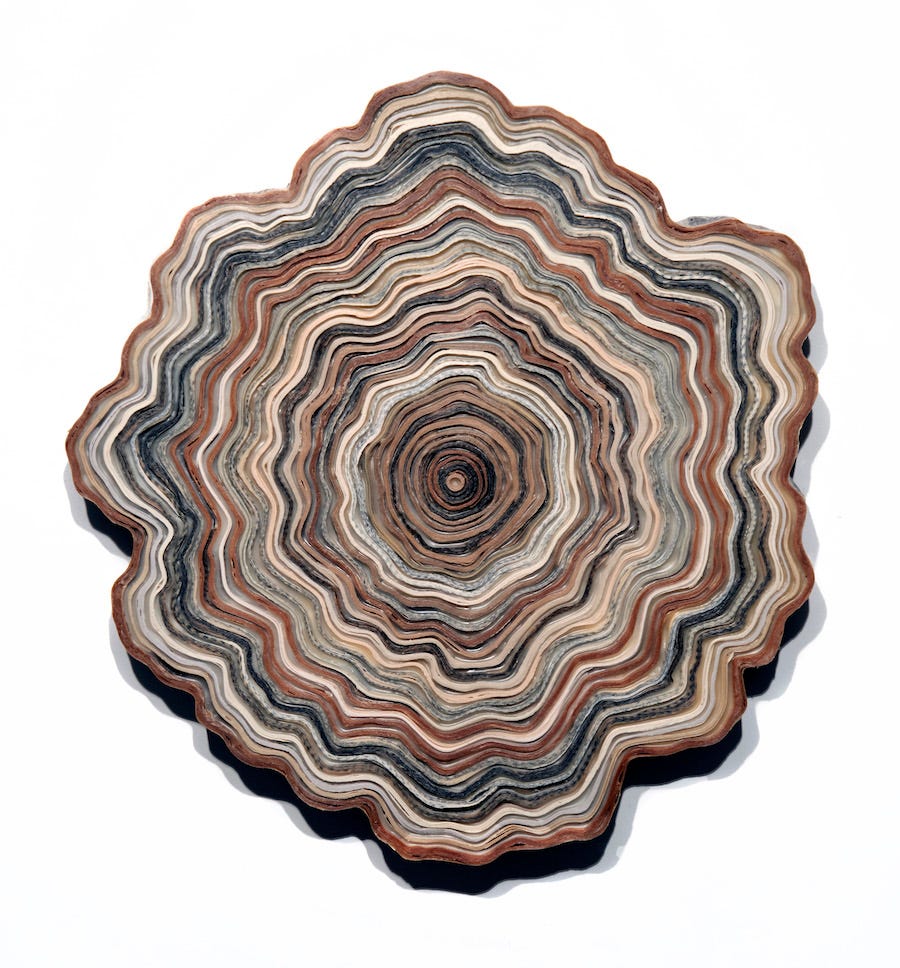More to Say
Text-driven art by Ruth Lozner & Kenzie Raulin, Xiaosheng Bi, and the participants in two group shows, "More than Words" and "WOW 8"
Ruth Lozner and Kenzie Raulin, “Keep Away from Children” (Ruth Lozner and Kenzie Raulin)
VENERABLE BOOKS AND DOCUMENTS ARE SCORCHED AND SHREDDED by recent events in "Within the Process: A Visual Response to Our World," a collaboration between local artists Ruth Lozner and Kenzie Raulin. Appropriately located at the Writer's Center, the show is predominantly wordy, but sometimes ventures into imagery. Not too far, usually: The duo's parody of a Jackson Pollock painting scatters hundreds of white 3D letters amid the multi-color paint splatters.
This wry example of what the artists call "Pollock's early literary phase" is not their only art-history jibe. They also used the latest technology to produce commentary, puckishly framed, by an "AI art critic." But most of the pieces address the contemporary political climate -- even if the literal subject is someone from the 19th century such as Eunice Newton Foote, a women's rights campaigner and a scientist who discovered the phenomenon known as the greenhouse effect.
Some of Lozner and Raulin's creations are perhaps a little too open-ended. A button that reads "we are" allows people to add a third word, as illustrated in a series of photos of people who wear personalized versions of the badge. An accordion-pleated sign spells out "truth" in letters outlined in either red or blue, depending on the viewer's vantage. The piece is titled, generously, "It depends on where you stand."
More pointed are "Executive Order," a scroll inscribed with words and phrases effectively unwritten by the Trump II administration, and two works about recent efforts to suppress books. "Library for the American Citizen" presents framed pages from Silent Spring, the Communist Manifesto, the Unabomber manifesto, and 13 other controversial texts. "Keep Away from Children" is an assortment of charred matchbooks, a few neatly arrayed and the others in a heap; each bears the title of a book that someone wants to suppress. The fire damage is both symbolic and real.
The ideas crackle in this show, but they wouldn't be as effective if the artists had simply sketched them on a napkin. Each piece is exquisitely crafted, with impressive attention to detail. Context matters, as Lozner and Raulin demonstrate by delivering their observations in museum-quality packaging.
HALF CALLIGRAPHY AND HALF CERAMICS, XIAOSHENG BI'S "Confrontation. Compromise." illustrates the sometimes uneasy balance between custom and improvisation. The China-born Maryland artist's show at VisArts (where he maintains a studio) includes a dozen examples of delicate but brightly painted porcelain, including bowls, jars, and a teapot. Contrasting them are three exuberant examples of earth-toned stoneware, executed in a rough-edged style associated more often with Japan than China.
In Xiaosheng's calligraphy, the tension is embodied within the same piece. He writes Chinese characters in brash black strokes that emphasize free gesture over received meaning. Connoisseurs may be able to read the script, but the only text-picture I find legible is "Shan Shui," in which the paper is nearly covered by bold black forms. Beneath them in gray, and much smaller, are dozens of the hanzi (characters) for mountain ("shan") or water ("shui"). These two characters are likely also the larger hanzi, although those are written too loosely to be deciphered assuredly.
Taken together, "shan" and "shui" comprise the Chinese term for traditional landscape painting. So "Shan Shui" can be seen as a landscape, rendered entirely with language rather than imagery. While Xiaosheng stretches hanzi to their limits, he respects their standard use.
Jessica Drenk, “Circulation 21” (Adah Rose Gallery)
TEXT ALSO BECOMES LANDSCAPE IN "MORE THAN WORDS (Mehr als Worte)," a four-artist exhibition at the Goethe-Institut's D.C. location. The lineup features two of the participants in Workhouse Arts Center's "Required Reading," which closed last month, but this show is smaller and its works are more modest in scale.
Curated by Adah Rose Bitterbaum and the Goethe-Intitut's Teddy Rodger, the show includes two of Adah Rose Gallery's artists, Scott Hazard (also seen in "Required Reading") and Jessica Drenk. The former makes multi-level paper sculptures in which cave-like excavations are framed by typed words or phrases, repeated and overlapped. Text entirely vanishes into primal forms in Drenk's sculptural pieces, some of which compress printed matter into what appear to be slices of tree trunk, seemingly cut to reveal their rings.
The words are more personal but less legible in Julia Bloom's offerings, which tightly overlap typed excerpts from her diary. As with her contributions to "Required Reading," Bloom's pictures place heavy semicircles on top, obscuring specific meaning beneath elementary shapes. Overlapping and repeated words feature as well in Madyha Leghari's text pieces, but they're handwritten rather than typed and sometimes shaped into the form of a woman's body. When the multilingual Pakistan-born artist laments "a lost mothertongue," the spidery words almost become flesh.
Judith Goodman installation (photo by Frank van Riper)
THE EIGHTH INSTALLMENT OF "WINDOWS ON WISCONSIN" (condensed as "WOW 8") pairs artists with poets in six of the seven Chevy Chase storefronts curated by neighborhood artist Kirsty Little. Artist-poet Elizabeth Ashe goes it alone in her display space, in which the Southern California native arrays small figurines and warns, "never build or live in the hills."
The indoor-outdoor aspect of the 24/7 show seems to have encouraged thoughts of the natural world. The duet with poet Tara Prakash inspired Veronique Legot to render a profusion of natural forms in a mix of painting and sculpture; Gayle Friedman arranges industrial-style flowers from looped bandsaw blades that dangle in the space she shares with Saskia van Groningen's verse. Printed on colored-paper strips arranged into a funnel cloud, Tanya Olson's words are particularly prominent in the window that also features Pam Gregory's mother-daughter domestic vignette.
Charles Simic's verse is upstaged by the most striking installation, Judith Goodman's cluttered array of hanging objects, surrealist dollhouses, and an inhabited dress form. Positioned in front of a blood-red wall, the assortment of damaged and desiccated objects appears all the more haunted. The Gothic vibe seems entirely out of place in the upscale shopping district, which makes it all the more memorable. This outside-out view is arrestingly eerie.
Ruth Lozner & Kenzie Raulin: Within the Process: A Visual Response to Our World
Through June 26 at the Writer's Center, 4508 Walsh St., Bethesda. writer.org. 301-654-8664.
Xiaosheng Bi: Confrontation. Compromise.
Through June 13 at Concourse Gallery, VisArts, 155 Gibbs St., Rockville. www.visartscenter.org. 301-315-8200.
More than Words (Mehr als Worte)
Through June 13 at Goethe-Institut, 1377 R St. NW, suite 300. www.goethe.de/ins/us/en/sta/wsh.html. 202-847-4700.
WOW 8
Through June 13 at 5510 Wisconsin Ave., Chevy Chase.



